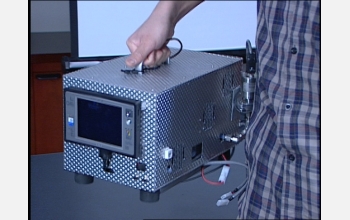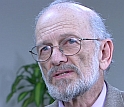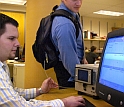News Release 06-044
Small, Ultra-fast and Ultra-versatile Scanner Takes Chemical Analysis to the Field
Surgical aid, medical diagnostic and bomb sniffer may be all in a day's work for this little machine

The Purdue miniature mass spectrometer can easily be carried with one hand.
March 16, 2006
This material is available primarily for archival purposes. Telephone numbers or other contact information may be out of date; please see current contact information at media contacts.
Researchers at Purdue University have developed a new, ultra-fast chemical-analysis system, with potential applications that range from sniffing luggage for explosive residues to detecting molecular disease markers in urine samples.
Recently, in fact, the researchers demonstrated that their system can rapidly and accurately detect the boundary between cancerous tissue and healthy tissue in the liver--information that could help surgeons make sure they had removed the entire tumor and spared the normal tissue.
"I wouldn't be surprised if pathologists are using this in operating rooms within two years," said Purdue's R. Graham Cooks, the analytical chemist who heads the research effort.
Cooks and his colleagues describe their work in the March 17 issue of the journal Science.
Much of their funding has been provided by the National Science Foundation and the Office of Naval Research, as well as by Inproteo LLC and Prosolia Inc, two Ind. companies engaged in commercializing technology developed at Purdue.
Cooks' team's overall goal has been to speed up and simplify the use of the mass spectrometer, an analytical device that has long been a laboratory fixture. In earlier work, the team tackled the large size, handling difficulties and expense of conventional mass spectrometers. Those efforts resulted in a portable, shoebox-sized instrument that weighs just 22 pounds (10 kilograms) in its current version, or about 30 times less than a conventional mass spectrometer. Moreover, that weight includes a battery pack that allows the miniaturized instrument to be carried into the field to reach the sample, rather than bringing the sample to the instrument in the lab.
Now, in the work reported in Science, the Purdue team has addressed the limitation that conventional mass spectrometers can analyze only samples that have been specially prepared. Their solution is a wand-like probe that can quickly gather chemical information from ordinary samples out in the open air. Based on a process known as desorption electrospray ionization, or DESI, the probe will essentially blast the molecules off any available surface using a mist of microscopic, ionized water droplets.
"The theme in our lab is, 'Don't mess with chemicals,' meaning we don't undertake the usual chemical separations and manipulations needed for conventional mass spectrometry," says Cooks.
For more details, see the Purdue University news release.
-NSF-
-
View Video
Cooks and Ouyang discuss the mini mass spectrometer and its potential applications.
Credit and Larger Version -
DESI technology can perform a molecular scan of any open surface, such as this backpack.
Credit and Larger Version
Media Contacts
M. Mitchell Waldrop, NSF, (703) 292-7752, email: mwaldrop@nsf.gov
Emil Venere, Purdue University, (765) 494-4709, email: venere@purdue.edu
Principal Investigators
R. Graham Cooks, Purdue University, (765) 494-5263, email: cooks@purdue.edu
Related Websites
R. Graham Cooks' Web site: http://www.chem.purdue.edu/cooks/rgcooks.html
The U.S. National Science Foundation propels the nation forward by advancing fundamental research in all fields of science and engineering. NSF supports research and people by providing facilities, instruments and funding to support their ingenuity and sustain the U.S. as a global leader in research and innovation. With a fiscal year 2023 budget of $9.5 billion, NSF funds reach all 50 states through grants to nearly 2,000 colleges, universities and institutions. Each year, NSF receives more than 40,000 competitive proposals and makes about 11,000 new awards. Those awards include support for cooperative research with industry, Arctic and Antarctic research and operations, and U.S. participation in international scientific efforts.
Connect with us online
NSF website: nsf.gov
NSF News: nsf.gov/news
For News Media: nsf.gov/news/newsroom
Statistics: nsf.gov/statistics/
Awards database: nsf.gov/awardsearch/
Follow us on social
Twitter: twitter.com/NSF
Facebook: facebook.com/US.NSF
Instagram: instagram.com/nsfgov


